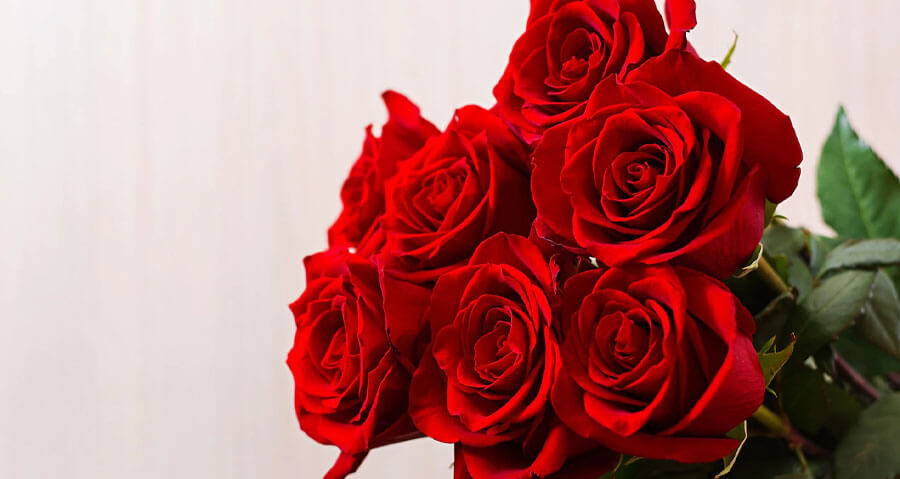Red roses have long been intertwined with expressions of love, passion, and romance, capturing the hearts and imaginations of people across various cultures. Their striking crimson hue and delicate, velvety petals have come to symbolize love and affection universally. Red roses are commonly exchanged as tokens of love and admiration during significant events such as Valentine’s Day, anniversaries, and weddings.
The history and symbolism of red roses are deeply rooted, tracing back through centuries of human expression and emotion. Their enduring popularity as gifts has solidified their position as an iconic symbol of love. This article aims to delve into red roses’ captivating history and profound symbolism, shedding light on their evolution into one of the most cherished and timeless tokens of affection.

The Origins of the Red Rose in Ancient Mythology
The story of red roses begins in ancient times when mythology and legend played a crucial role in shaping their symbolism. In Greek mythology, the red rose is often associated with the goddess Aphrodite, the embodiment of love and beauty. According to the myth, when a wild boar mortally wounded her lover, Adonis, Aphrodite rushed to his side, and in her haste, she pricked her foot on a thorny bush of white roses. Her blood stained the roses red, forever transforming them into deep, passionate love symbols.
Similarly, in Roman mythology, the red rose is linked to Venus, the goddess of love. It is said that the red rose bloomed from Venus’s tears and blood as she mourned the death of her beloved, Adonis. Therefore, the rose became a symbol of love and mourning, a reminder of the beauty and pain that often accompany deep emotional connections.
These ancient myths laid the foundation for the red rose’s association with love and passion, a connection that has persisted throughout history.
Symbolism in Literature and Art
As time passed, the red rose continued to appear in various forms of literature and art, further cementing its role as a symbol of love and desire. During the Middle Ages, the red rose became a prominent motif in poetry and song, often used to represent the beauty and purity of a lover. The rose was a central figure in the literature of the time, symbolizing not only love but also the ideals of chivalry and honor.
One of the most famous literary uses of the red rose is in Shakespeare’s works. In Romeo and Juliet, the red rose is a powerful symbol of the forbidden love between the two protagonists. The rose, with its beauty and thorns, represents the dual nature of love—the joy and the pain, the ecstasy and the danger.
The red rose also became a popular subject in Renaissance art, where it was often depicted in paintings and tapestries as a symbol of love, beauty, and the divine. These artistic representations helped solidify the red rose’s status as a universal emblem of romance and passion.

The Red Rose in Religious Symbolism
The symbolism of the red rose is not confined to secular contexts; it also has deep roots in religious traditions. In Christianity, the red rose is often associated with the Virgin Mary, symbolizing her purity, love, and suffering. The rose is frequently used in religious art to represent the blood of Christ, particularly in depictions of the Passion.
The connection between the red rose and religious symbolism further enhanced its status as a meaningful and powerful symbol, extending its significance beyond the realm of romantic love to encompass spiritual devotion and sacrifice.
The Rise of the Red Rose in Victorian England
The Victorian era marked a significant period in the history of the red rose as a symbol of love and romance. During this time, the practice of floriography, or the language of flowers, became immensely popular. In a society where direct expression of emotions was often considered inappropriate, flowers became a way to communicate feelings and sentiments discreetly.
Commercialization of Red Roses
The 20th century saw the commercialization of the red rose, particularly around Valentine’s Day. As consumer culture grew, the red rose became a staple gift, marketed heavily as the perfect symbol of love and romance. Florists capitalized on the established symbolism of the red rose, and it became the most popular flower to give on Valentine’s Day, often accompanied by chocolates and other tokens of affection.
The commercialization of the red rose has made it a ubiquitous symbol, instantly recognizable and widely available. However, despite its mass production, the red rose has retained its romantic allure and remains a powerful expression of love.

The Red Rose in Modern Times
Today, the red rose continues to hold its place as the ultimate symbol of love and passion. Whether given as a single stem or as part of a larger bouquet, the red rose carries a message that transcends words; it is a symbol passed down through generations, evolving in meaning yet remaining steadfast in its association with love.
In modern times, the red rose is often used in various ceremonies and celebrations, from weddings to anniversaries, as a way to express love and commitment. It is also a popular choice for those seeking to apologize or reconcile, as the red rose symbolizes sincerity and deep emotion.
Furthermore, the red rose has found its way into popular culture, appearing in films, music, and fashion. It is a symbol that continues to inspire artists and lovers alike, a timeless emblem of passion and desire.
Conclusion
Whether for a romantic gesture, a celebration of love, or a simple expression of admiration, the red rose remains a cherished and meaningful gift. Its rich history and symbolism continue to resonate with people around the world, making the red roses bouquet a timeless expression of love that will never go out of style.

I am a powerful force in the workplace and uses my positive attitude and tireless energy to beat others to work hard and achieve success. I am also inspired daily by my wife and their two daughters. In my free time, I like to go hiking, crochet and play video games.


